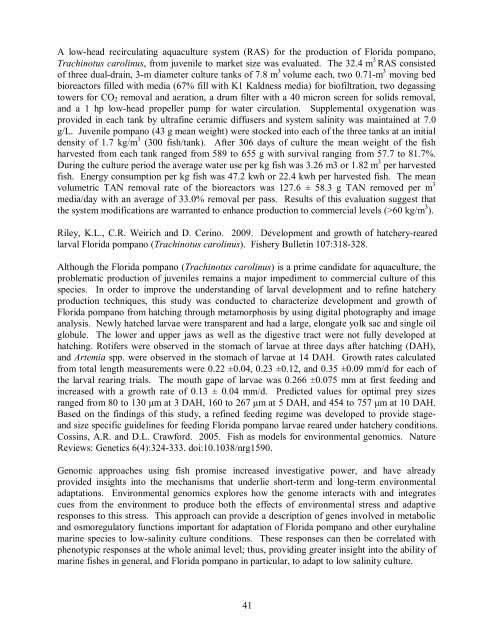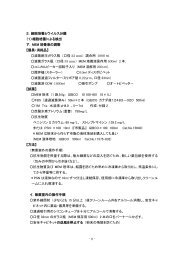Program and Abstracts(PDF)
Program and Abstracts(PDF)
Program and Abstracts(PDF)
Create successful ePaper yourself
Turn your PDF publications into a flip-book with our unique Google optimized e-Paper software.
A low-head recirculating aquaculture system (RAS) for the production of Florida pompano,<br />
Trachinotus carolinus, from juvenile to market size was evaluated. The 32.4 m 3 RAS consisted<br />
of three dual-drain, 3-m diameter culture tanks of 7.8 m 3 volume each, two 0.71-m 3 moving bed<br />
bioreactors filled with media (67% fill with K1 Kaldness media) for biofiltration, two degassing<br />
towers for CO 2 removal <strong>and</strong> aeration, a drum filter with a 40 micron screen for solids removal,<br />
<strong>and</strong> a 1 hp low-head propeller pump for water circulation. Supplemental oxygenation was<br />
provided in each tank by ultrafine ceramic diffusers <strong>and</strong> system salinity was maintained at 7.0<br />
g/L. Juvenile pompano (43 g mean weight) were stocked into each of the three tanks at an initial<br />
density of 1.7 kg/m 3 (300 fish/tank). After 306 days of culture the mean weight of the fish<br />
harvested from each tank ranged from 589 to 655 g with survival ranging from 57.7 to 81.7%.<br />
During the culture period the average water use per kg fish was 3.26 m3 or 1.82 m 3 per harvested<br />
fish. Energy consumption per kg fish was 47.2 kwh or 22.4 kwh per harvested fish. The mean<br />
volumetric TAN removal rate of the bioreactors was 127.6 ± 58.3 g TAN removed per m 3<br />
media/day with an average of 33.0% removal per pass. Results of this evaluation suggest that<br />
the system modifications are warranted to enhance production to commercial levels (>60 kg/m 3 ).<br />
Riley, K.L., C.R. Weirich <strong>and</strong> D. Cerino. 2009. Development <strong>and</strong> growth of hatchery-reared<br />
larval Florida pompano (Trachinotus carolinus). Fishery Bulletin 107:318-328.<br />
Although the Florida pompano (Trachinotus carolinus) is a prime c<strong>and</strong>idate for aquaculture, the<br />
problematic production of juveniles remains a major impediment to commercial culture of this<br />
species. In order to improve the underst<strong>and</strong>ing of larval development <strong>and</strong> to refine hatchery<br />
production techniques, this study was conducted to characterize development <strong>and</strong> growth of<br />
Florida pompano from hatching through metamorphosis by using digital photography <strong>and</strong> image<br />
analysis. Newly hatched larvae were transparent <strong>and</strong> had a large, elongate yolk sac <strong>and</strong> single oil<br />
globule. The lower <strong>and</strong> upper jaws as well as the digestive tract were not fully developed at<br />
hatching. Rotifers were observed in the stomach of larvae at three days after hatching (DAH),<br />
<strong>and</strong> Artemia spp. were observed in the stomach of larvae at 14 DAH. Growth rates calculated<br />
from total length measurements were 0.22 ±0.04, 0.23 ±0.12, <strong>and</strong> 0.35 ±0.09 mm/d for each of<br />
the larval rearing trials. The mouth gape of larvae was 0.266 ±0.075 mm at first feeding <strong>and</strong><br />
increased with a growth rate of 0.13 ± 0.04 mm/d. Predicted values for optimal prey sizes<br />
ranged from 80 to 130 μm at 3 DAH, 160 to 267 μm at 5 DAH, <strong>and</strong> 454 to 757 μm at 10 DAH.<br />
Based on the findings of this study, a refined feeding regime was developed to provide stage<strong>and</strong><br />
size specific guidelines for feeding Florida pompano larvae reared under hatchery conditions.<br />
Cossins, A.R. <strong>and</strong> D.L. Crawford. 2005. Fish as models for environmental genomics. Nature<br />
Reviews: Genetics 6(4):324-333. doi:10.1038/nrg1590.<br />
Genomic approaches using fish promise increased investigative power, <strong>and</strong> have already<br />
provided insights into the mechanisms that underlie short-term <strong>and</strong> long-term environmental<br />
adaptations. Environmental genomics explores how the genome interacts with <strong>and</strong> integrates<br />
cues from the environment to produce both the effects of environmental stress <strong>and</strong> adaptive<br />
responses to this stress. This approach can provide a description of genes involved in metabolic<br />
<strong>and</strong> osmoregulatory functions important for adaptation of Florida pompano <strong>and</strong> other euryhaline<br />
marine species to low-salinity culture conditions. These responses can then be correlated with<br />
phenotypic responses at the whole animal level; thus, providing greater insight into the ability of<br />
marine fishes in general, <strong>and</strong> Florida pompano in particular, to adapt to low salinity culture.<br />
41



